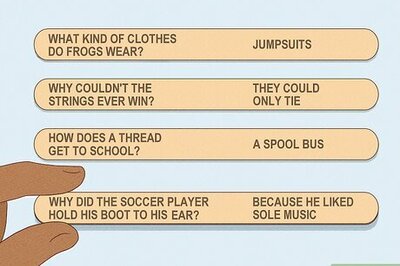
views
I burnt myself making soup in the kitchen today. One of those things where you try to do too many things at the same time- and end up covered with boiling hot soup.
I am a mother of two- had my share of physical pain- but I am sure you who will agree, the pain from burns is in a category of its own. Doctors say that's because it's not just your skin that burns- but tissues inside that continue to simmer and hurt long after the original injury.
And as I splashed my arms down with iced water- the image kept flashing through my mind- an image I have been trying to put out for the past week. Of a man in Gaya called Manoj Mishra.
Incase you missed the story - or in fact were fortunate to have missed its continuous replay on television on independence day- let me recap. Manoj Mishra was a dairy contractor at the government run Sudha Dairy in Gaya. He left his home that day, telling his wife and 14 year old son he would be back soon. No one knows why he decided to set himself on fire to protest the non-payment of his bills by the dairy. No one knows why he decided to call local television crews to watch. But he did, and they did.
According to some reports- one of the cameramen actually helped Mishra in his self-destructive act, handing him matches and kerosene when a first attempt to set his clothes on fire didn't work. Success the second time around- and Mishra died a short while later of 80 percent burns.
The police has filed an FIR against media members gathered for abetting the suicide- whatever the truth of the charge- the sickening reality is there for all to view: all the cameramen and journalists watched, recorded and filed, as Mishra set his blanket on fire, the startled look on his face as it spread to his clothes, the panic and alarm as he ran around trying to put out the flames, the agony as he thrashed about on the ground, and cried for help- and then as shock set in, Mishra sat down on the ground, quietly awaiting the inevitable. Silence.
In all the video I saw- the cameraman kept his camera steady through Mishra's ordeal, calmly tilting, panning and following the 'shot', never once taking the camera off its tripod base, never once disturbing the frame by going in to help the suffering shrieking man- and no other journalist did either.
What goes through your mind as you watch someone die? Not much it seems. Only two months ago- we followed the heated debate over what the crowd's reaction should have been when a Patiala trader set himself on fire in another protest. There too, the crowd watched, the cameras whirred, the man died.
And this week, video emerged of a family in Falna, Rajasthan. They were trapped in their car as it was swept away in a flash flood there- screaming to be saved. In the video you see crowds watching in horror. But only two people jumped in to the water to try and help- both army jawans- one of whom drowned in the effort. I guess you can't blame the people (including apparently, 1 state minister) for not being able to help. But I do blame all of them,yes,including fellow journalists, for not even trying. Capturing dramatic events on tape is what keeps our livelihood, but allowing people to die as we watch takes away our humanity.
In May 1996, 8 people were killed in one of the deadliest storms on Mount Everest. David Breashears, a climber/cameraman was filming the expedition that year for an IMAX film, a mega screen documentary that had never been attempted before. An ambitious project costing over a million dollars.
Breashears could have continued to film through the tragedy - instead he chose to put down his camera, and went out and escorted several people to safety. Not only that, he offered his own oxygen,batteries and supplies to climbers stuck on the mountain until help arrived. He was asked about how he made the choice, basically jeopardizing his film to do what he did (he went back later to complete the film). And his answer was simple- "When the storm came down, I could either keep filming, or I could turn the camera off, and try and help someone out. Where's the choice?"
Many say it is the job of journalists to observe what happens, not to get involved in the story. After all, we cover floods, riots, and all sorts of disasters- and we don't seem to get involved in the rescue efforts. And I agree - but in most of those cases, there is already a rescue effort in place, and there isn't an immediate danger of someone dying in front of your eyes while you safely film and watch. In other cases,judgement calls are hard to make- you might panic, you might be afraid for your life, you may be stuck yourself and can't help.
But as a man watches you watch him die - you can't simply carry on doing what you are doing - like it's just another story.
About the AuthorSuhasini Haidar Suhasini Haidar is Diplomatic Editor, The Hindu. Earlier, she was a senior editor and prime time anchor for India's leading 24-hour English news chann...Read Morefirst published:August 25, 2006, 12:51 ISTlast updated:August 25, 2006, 12:51 IST
window._taboola = window._taboola || [];_taboola.push({mode: 'thumbnails-mid-article',container: 'taboola-mid-article-thumbnails',placement: 'Mid Article Thumbnails',target_type: 'mix'});
let eventFire = false;
window.addEventListener('scroll', () => {
if (window.taboolaInt && !eventFire) {
setTimeout(() => {
ga('send', 'event', 'Mid Article Thumbnails', 'PV');
ga('set', 'dimension22', "Taboola Yes");
}, 4000);
eventFire = true;
}
});
window._taboola = window._taboola || [];_taboola.push({mode: 'thumbnails-a', container: 'taboola-below-article-thumbnails', placement: 'Below Article Thumbnails', target_type: 'mix' });Latest News
As a man watches you watch him die - you can't simply carry on doing what you are doing - like it's just another story.
I burnt myself making soup in the kitchen today. One of those things where you try to do too many things at the same time- and end up covered with boiling hot soup.
I am a mother of two- had my share of physical pain- but I am sure you who will agree, the pain from burns is in a category of its own. Doctors say that's because it's not just your skin that burns- but tissues inside that continue to simmer and hurt long after the original injury.
And as I splashed my arms down with iced water- the image kept flashing through my mind- an image I have been trying to put out for the past week. Of a man in Gaya called Manoj Mishra.
Incase you missed the story - or in fact were fortunate to have missed its continuous replay on television on independence day- let me recap. Manoj Mishra was a dairy contractor at the government run Sudha Dairy in Gaya. He left his home that day, telling his wife and 14 year old son he would be back soon. No one knows why he decided to set himself on fire to protest the non-payment of his bills by the dairy. No one knows why he decided to call local television crews to watch. But he did, and they did.
According to some reports- one of the cameramen actually helped Mishra in his self-destructive act, handing him matches and kerosene when a first attempt to set his clothes on fire didn't work. Success the second time around- and Mishra died a short while later of 80 percent burns.
The police has filed an FIR against media members gathered for abetting the suicide- whatever the truth of the charge- the sickening reality is there for all to view: all the cameramen and journalists watched, recorded and filed, as Mishra set his blanket on fire, the startled look on his face as it spread to his clothes, the panic and alarm as he ran around trying to put out the flames, the agony as he thrashed about on the ground, and cried for help- and then as shock set in, Mishra sat down on the ground, quietly awaiting the inevitable. Silence.
In all the video I saw- the cameraman kept his camera steady through Mishra's ordeal, calmly tilting, panning and following the 'shot', never once taking the camera off its tripod base, never once disturbing the frame by going in to help the suffering shrieking man- and no other journalist did either.
What goes through your mind as you watch someone die? Not much it seems. Only two months ago- we followed the heated debate over what the crowd's reaction should have been when a Patiala trader set himself on fire in another protest. There too, the crowd watched, the cameras whirred, the man died.
And this week, video emerged of a family in Falna, Rajasthan. They were trapped in their car as it was swept away in a flash flood there- screaming to be saved. In the video you see crowds watching in horror. But only two people jumped in to the water to try and help- both army jawans- one of whom drowned in the effort. I guess you can't blame the people (including apparently, 1 state minister) for not being able to help. But I do blame all of them,yes,including fellow journalists, for not even trying. Capturing dramatic events on tape is what keeps our livelihood, but allowing people to die as we watch takes away our humanity.
In May 1996, 8 people were killed in one of the deadliest storms on Mount Everest. David Breashears, a climber/cameraman was filming the expedition that year for an IMAX film, a mega screen documentary that had never been attempted before. An ambitious project costing over a million dollars.
Breashears could have continued to film through the tragedy - instead he chose to put down his camera, and went out and escorted several people to safety. Not only that, he offered his own oxygen,batteries and supplies to climbers stuck on the mountain until help arrived. He was asked about how he made the choice, basically jeopardizing his film to do what he did (he went back later to complete the film). And his answer was simple- "When the storm came down, I could either keep filming, or I could turn the camera off, and try and help someone out. Where's the choice?"
Many say it is the job of journalists to observe what happens, not to get involved in the story. After all, we cover floods, riots, and all sorts of disasters- and we don't seem to get involved in the rescue efforts. And I agree - but in most of those cases, there is already a rescue effort in place, and there isn't an immediate danger of someone dying in front of your eyes while you safely film and watch. In other cases,judgement calls are hard to make- you might panic, you might be afraid for your life, you may be stuck yourself and can't help.
But as a man watches you watch him die - you can't simply carry on doing what you are doing - like it's just another story.

















Comments
0 comment